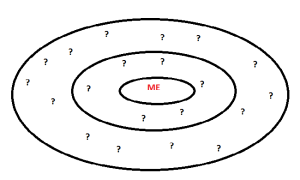There is a saying, supposedly Buddhist, that “when the student is ready, the teacher will appear”. This week in #rhizo14 we are looking at the opposite to this – how should the teacher disappear – how do we empower our learners to begin to think for themselves? It’s something that I try to do in my tutorials by using the Jigsaw Technique and a neo-Vygotskian approach to learning which means that I begin the year with fairly structured activities for small group work and, as the semester progresses, I gradually provide less and less support. My proudest moment was when a group told me that they didn’t need me to hang around at the end of a class, they could carry on without me. And then they did.
A metaphor I often use when I am teaching, especially when I am working with adult learners, is that of a ladder. I like to think that I started somewhere near the bottom and that, in some way, I have climbed up some way. Maybe it’s not very rhizomatic, but I find it helps to explain to some folk the thought that “experts” are not more intelligent than “novices”, they have just had longer to learn and become familiar with subject matter.
And, or course, it allows me to quote one of my favourite parts of one of my favourite thinkers:
My propositions are elucidatory in this way: he who understands me finally recognizes them as senseless, when he has climbed out through them, on them, over them. (He must so to speak throw away the ladder, after he has climbed up on it.)
He must surmount these propositions; then he sees the world
rightly. Wittgenstein. Tractatus Section 6.54
Need I say more?

![London Underground being used as an Air Raid Shelter Image by US Govt [Public domain], via Wikimedia Commons](http://94.136.40.103/~nomadwarmachine.co.uk/wp-content/uploads/2014/02/Blitz_West_End_Air_Shelter-240x300.jpg)


![Image by Mattgirling (Own work) [CC BY-SA 3.0 (http://creativecommons.org/licenses/by-sa/3.0) or GFDL (http://www.gnu.org/copyleft/fdl.html)], via Wikimedia Commons](http://94.136.40.103/~nomadwarmachine.co.uk/wp-content/uploads/2014/02/Eiffel_Tower-201x300.jpg)

![Image by Rémi Kaupp (Self-photographed) [GFDL (http://www.gnu.org/copyleft/fdl.html), CC-BY-SA-3.0 (http://creativecommons.org/licenses/by-sa/3.0/) or CC BY-SA 2.5-2.0-1.0 (http://creativecommons.org/licenses/by-sa/2.5-2.0-1.0)], via Wikimedia Commons](http://94.136.40.103/~nomadwarmachine.co.uk/wp-content/uploads/2014/02/Wooden_boat_wrecked-300x225.jpg)
 1. I love frogs. I grew up in the Peak District in a village called
1. I love frogs. I grew up in the Peak District in a village called 







